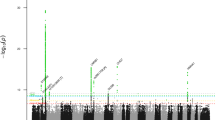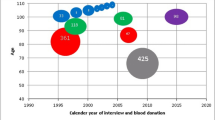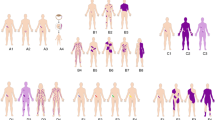Abstract
RECENTLY, P. S. Gerald et al.1 published their observations on haptoglobin (Hp) in a family with a child in which one of the D group chromosomes (13, 14 or 15) was deformed into a ring structure, which implies that part of the chromosomal material of the chromosome is deleted. It appeared that the carrier of this chromosome lacked the Hp genetical contribution from her father (father, Hp 2-2; mother, Hp 2-1; carrier child, Hp 1-1). Therefore the authors tentatively proposed that the haptoglobin locus is on the end of the long arm of a D chromosome. We had the opportunity to study a number of families with translocations, and our preliminary results are presented as additional information on the localization of Hp.
This is a preview of subscription content, access via your institution
Access options
Subscribe to this journal
Receive 51 print issues and online access
$199.00 per year
only $3.90 per issue
Buy this article
- Purchase on Springer Link
- Instant access to full article PDF
Prices may be subject to local taxes which are calculated during checkout
Similar content being viewed by others
References
Gerald, P. S., Warner, S., Singer, J. D., Corcoran, P. A., and Umansky, I., J. Clin. Invest., 43, 1297 (1964).
Hamerton, J. L., Giannelli, F., and Carter, C. O., Cytogenetics, 2, 194 (1963).
Macintyre, M. N., Staples, W. I., Steinberg, A. G., and Hempel, J. M., Amer. J. Hum. Genetics, 14, 335 (1962).
Author information
Authors and Affiliations
Rights and permissions
About this article
Cite this article
HUSTINX, T., BIJLSMA, J. & NIJENHUIS, L. Localization of Haptoglobin and ABO. Nature 207, 327–328 (1965). https://doi.org/10.1038/207327b0
Issue Date:
DOI: https://doi.org/10.1038/207327b0
Comments
By submitting a comment you agree to abide by our Terms and Community Guidelines. If you find something abusive or that does not comply with our terms or guidelines please flag it as inappropriate.



